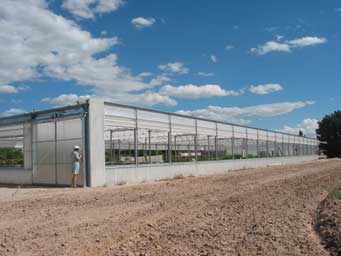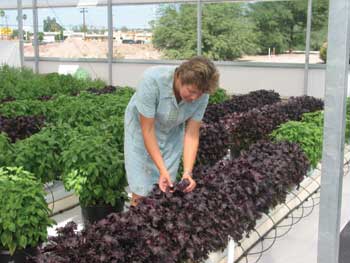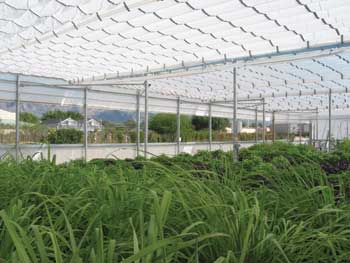Retractable Roof Greenhouse Cultivation Offers Flexibility
Plants
thrive under moveable shade
2003
Arizona Agricultural Experiment Station Research Report
![]()
Written by
Susan McGinley
The difference couldn’t be more dramatic: the basil plants in the
ground outside look small and spindly compared to the luxuriant green
and purple-leaved specimens growing in the retractable roof greenhouse.
Part of a study exploring niche markets for fresh herbs, basil is one
of several projects in progress inside this commercial grade facility
at the University of Arizona’s Campus Agricultural Center in Tucson.
Inside the quarter-acre building, plants get the best of both sun and shade depending on prevailing conditions. Too much wind? Let down the side walls. Need more sun? Roll back the flat roof a little. Somewhat less enclosed than a regular greenhouse, the retractable roof greenhouse is the next best thing to being outdoors if you’re a plant, according to plant scientist Ursula Schuch. You get the ventilation and light while controlling for wind, too much sun, or cold temperatures.
| “We can completely open or close the roof and side walls,” she says. “The roof is water permeable so rain can leak through slowly—unless it’s more than two inches per hour, which would be too much.” Water congregates along driplines in the spun polyethylene roofing material. Woven in two different thicknesses, the fabric provides 35 percent and 50 percent shade in an alternating arrangement down the length of the building. A black ground covering keeps out weeds and prevents crop roots from growing out of pots into the ground. Each of the six growing bays is 60 feet by 180 feet, enough to accommodate several rows of pots fitted with hydroponic tubing. |
 |
|
All of this flexibility gives faculty and students the chance to test
herbs, bedding plants, shrubs, trees and vegetables using varying amounts
of solar radiation and ventilation. They use gauges to check soil temperature
and relative humidity around the plant canopy; computers regulate the
timing and operation of the roof panel motors and also the amount and
timing of irrigation and fertilizing.
Retractable roof greenhouses have been around for about 15 years but
are still considered relatively new, Schuch says. Most growers install
them in units of one to several acres, so this one is fairly small by
industry standards. She and several graduate students thus are conducting
experiments using the same technology available to the nursery industry,
but their emphasis right now is on crops that are not currently grown
in Arizona on a commercial scale.
The goal is to find out what grows well in desert retractable roof greenhouses
and determine the best techniques for producing high-value crops in them.
Workshops and tours are offered periodically to share research results
with growers. Experiments are sponsored by different organizations.
The basil study is funded by the Arizona Department of Agriculture to
explore the production of culinary herbs for high-end fresh-market sales
to restaurants and other gourmet outlets. Schuch and graduate student
Jennifer Nelkin chose basil because it’s a valuable cash crop with
a short shelf life. Among the finer restaurants in Phoenix and Tucson
there is a demand for this high-quality herb chopped up in pesto and other
dishes, and also as a garnish. The leaves need to be large, tender, flavorful,
attractive and unblemished.
|
Everything in the experiment is a series of twos: the researchers are comparing basil grown in media-filled pots and in rock wool, a hydroponic medium; they aregrowing two types of basil, “Purple Ruffles” and the green “Genovese”, under two types of shade. For comparison, the two basil cultivars are also planted in the ground outside the greenhouse. Integrated pest management techniques are used for controlling loopers and other pests. “These herbs are all organically grown,” Schuch says. “If we can’t grow the crop organically we’re not even interested.” Every week Nelkin harvests leaves from the plants and weighs the yields from all the treatments. The researchers also measure the size of the leaves, essential oils and several other parameters to learn how the different environments and cultural treatments affect plant growth.“We want to manipulate the root zone temperature, keeping it in the range optimum for growth, around 65 to 90 degrees Fahrenheit,” Schuch says. Temperatures higher or lower than that prevent the plant from photosynthesizing on a maximum basis and thus depress yields. The researchers are aiming to produce the maximum amount of high-quality shoot tips per plant. Next season they’ll grow the basil again to come up with the optimum cultural management strategy for doing that, including calculations on a per-acre basis for inputs and outputs and production cost estimates. |
 |
|
|
 |
|
|
How good is this basil? A chef at one of Tucson’s finer restaurants told Nelkin it’s the best he’s ever seen.
Other studies include testing lemon grass as a culinary herb; exploring tomato and pepper growing techniques; comparing dig dates and cold storage on performance and flowering of bareroot roses; and using integrated pest management to control rhyzoctonia (a fungus) on bedding plants.For any of these projects, the big objective is to manage the various components of the retractable roof greenhouse to maximize photosynthesis for optimum plant performance. Schuch admits that it can be a juggling act. “Yet it’s really exciting because there are so many questions and you have to think about how to use different strategies for each crop.”
 |
 |
|
The retractable panels are operated by motors mounted on the roof. The thick panel on the left provides 50 percent shade; the thinner one on the right, 35 percent shade. |
|
| Lemongrass, a culinary herb, thrives under the retractable roof. |
CONTACT:
Ursula Schuch
(520) 621-1060
ukschuch@ag.arizona.edu
Return to the Title Page
Return to the Table of Contacts
The University of Arizona is an Equal Opportunity/Affirmative
Action Employer. Any products, services, or organizations that are mentioned,
shown, or indirectly implied in this publication do not imply endorsement
by the University of Arizona.
Published January 2004
Return to College publication list